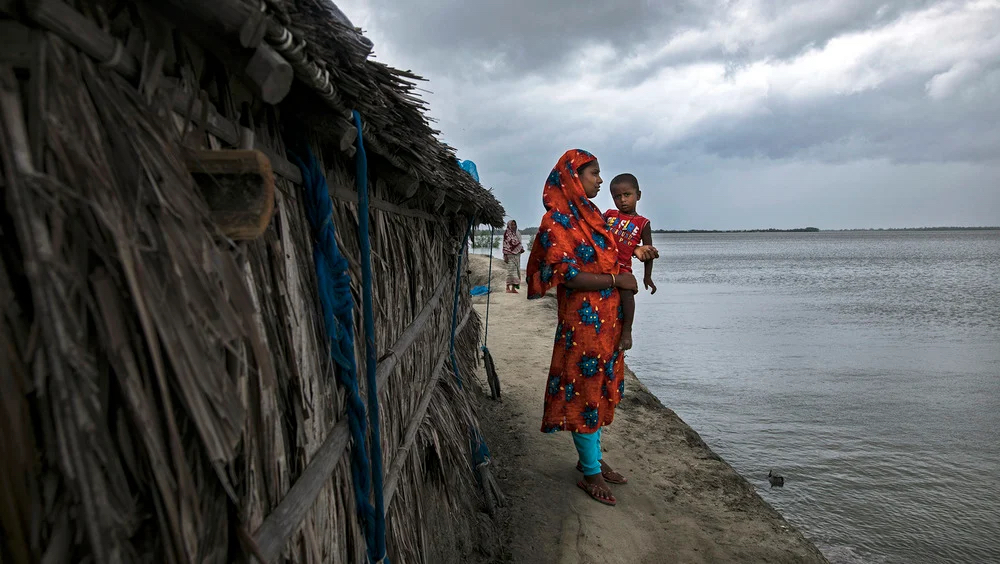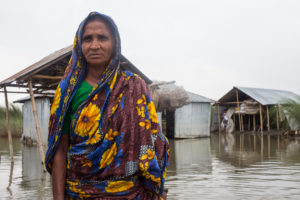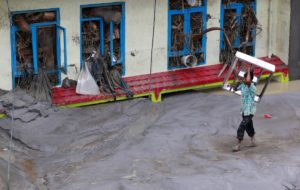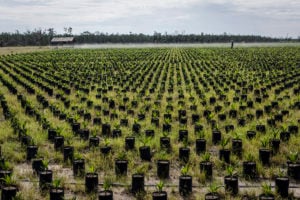When Cyclone Bhola hit what is now present-day Bangladesh in 1970, it killed 300,000 to 500,000 people. Among the dead were 52 of Abul Kashem’s relatives, swept away by what is still considered the deadliest storm ever recorded.
“I had to start my life from zero,” Kashem, now 80, told The New Humanitarian from his home in Dalalkandi, a village on the coast of Bangladesh about 360 kilometres south of the capital, Dhaka.
Editor’s note
This article was originally published by The New Humanitarian, a news agency specialised in reporting humanitarian crises.
A lot has changed since Bhola struck in 1970. Bangladesh’s population has more than doubled, and global heating has triggered even more frequent extreme events in the country – one of the world’s most vulnerable when it comes to weather-driven disasters.
Bangladesh, however, has also drastically reduced its cyclone-related deaths, by more than 100 fold since 1970 – an accomplishment noted in disaster risk reduction circles and backed up by a data-driven investigation by The New Humanitarian.
The six-month investigation, which combined analyses of risk and resilience datasets with on-the-ground reporting, also identified other “positive outliers” – countries with similar disaster risk and economic profiles that have been surprisingly successful at reducing deaths. Among them were Cuba, Indonesia, Mozambique, the Philippines and Vietnam.
Although worldwide death tolls from climate-related disasters have dropped over the years – partly because of technological advances that include weather satellites and alerts sent to mobile phones – Bangladesh provides a case study of good practices, especially for wealthier countries that are increasingly facing new climate risks.
Germany, for example, experienced unusually high rainfall in July – a rare event made up to nine times more likely by climate change, according to a study by the World Weather Attribution initiative, which measures the role of climate change in such events. Slow to warn people about potential floods, Germany’s death toll from the flash flooding was at least 180. Record rainfall also caught Canada off guard in November, displacing about 17,000 people and causing widespread damage in British Columbia.
Bangladesh still struggles to minimise damage from storms – a factor that has contributed to an uptick in migration, mostly from coastal areas to cities – but it has reduced deaths by using a multi-layered early warning system, a vast network of cyclone shelters, a large volunteer programme whose force is 50% women, and storm-aware curricula that begin early in schools.
Although it’s not considered a world leader in disaster risk reduction – countries such as Japan have had notable successes but also have larger economies – Bangladesh still offers a model of good practices for other countries around the world.
For starters, Bangladesh earmarks a larger proportion of its own finances to tackle climate problems than many developing countries.
Since 2010, for example, the Bangladesh Climate Change Trust Fund (BCCTF) has channelled domestic funds – approximately USD 450 million as of 2021 – to climate-related projects across the country. According to the country’s Climate Budget Report, more than 7% of the national budget was allocated to tackling climate change between 2021 and 2022.
By comparison, Indonesia – which also ranked well in The New Humanitarian’s analysis of countries successfully reducing cyclone-related deaths – allocated 3.5% and 4.9% of its government budget to climate change activities in 2016 and 2018, respectively. The Philippines, meanwhile, dedicated 6.2% of its national budget to climate change in 2021.
“We used to lose lives by the hundreds of thousands,” Saleemul Huq, director of the International Centre for Climate Change and Development (ICCCAD) in Dhaka, told The New Humanitarian in August. “We still have floods and cyclones that cause a lot of damage, but we don’t lose lives any more.”
Early warnings
Cyclone Bhola took many by surprise, including Rahela Khatun, who lost her three children.
“We were not warned that Bhola was coming,” Khatun, now 72, told The New Humanitarian from Sakuchia, a village 300 kilometres south of Dhaka.
In 1970, Bangladesh had only two coastal radars, which monitored storms situated less than 200 miles from its shores.
The country also relied on satellite images issued by other agencies, such as the US-based National Earth Satellite Center (NESC), but communication delays meant that images reached the country – then called East Pakistan – up to 23 hours after the pictures were taken, as was the case with Bhola.
Bangladesh now collects meteorological data through a network of more than 50 weather stations, balloons and radars.
As a member of the World Meteorological Organization (WMO), it also receives information from other national and regional meteorological offices.
Bangladesh’s weather agency feeds forecasts to national and local disaster mitigation committees, which send early warnings that involve multiple layers: radio announcements, targeted text messages to people who may be affected, television alerts, announcements broadcast over speakers in mosques, and volunteers going door to door.
Warning signals are also communicated to seaports and updated every 15 or 30 minutes, depending on the level of warning. Warning levels are ranked on a scale of one to 11 – one to four for a precautionary warning, five to seven for danger, and eight to 11 for great danger.
Each level triggers a series of measures and messages for the community, from preparing battery-run radios and torch lights, to evacuating to cyclone shelters.
Bangladesh also uses targeted text messages and pre-recorded disaster alerts, which people can listen to by dialling 1090.
Text messages have sometimes been criticised for arriving late in other countries, such as the Philippines. Part of this has been attributed to how the alert is sent – there are two types of message broadcast systems, short messaging system (SMS) and cell broadcast service (CBS).
CBS sends faster messages to mobile phones because it relies on pre-arranged cell sites without the need to register the phones. It also allows for location-specific alerts. But not every mobile phone enables CBS alerts by default, so authorities sometimes use slower SMSs, which can jam communications and generate delays.
To overcome these limitations, countries need to multiply communication channels, according to a WMO checklist of best practices. Bangladesh, for example, has started to use push notifications – short alerts sent to mobile phones via the internet.
Although many countries in Southeast Asia have established early warning systems for storms, up until last year only 40% of the WMO’s 193 member states had a multi-hazards early warning system that identifies, monitors and warns against different types of hazards, such as storms, volcanic eruptions, or floods.
For example, Pakistan’s National Disaster Management Authority said it was still relying on outdated and often deficient meteorological and hydrological sensors, which sometimes prevented the country from issuing timely warnings for flash floods in certain regions.
Early warnings have also been impacted by Pakistan’s reliance on information shared by India about waterflow in its eastern rivers, which have their sources in India. This information is not always shared, Mahr Khan, chief meteorologist at the Provincial Disaster Management Authority in Punjab, told The New Humanitarian in November.
Female volunteers
Two years after Bhola struck, the Bangladesh Red Crescent Society launched a Cyclone Preparedness Programme (CPP) to ensure people were aware of warnings and could evacuate.
Today, the programme has more than 200 staff and 76,000 volunteers – half of whom are women.
Shahida Begum started volunteering after losing her seven-year-old son Ibrahim during Cyclone Sidr, which killed some 3,500 people in 2007.
“I will never forget that grief,” she told The New Humanitarian. “I became a volunteer so that other mothers in the village don’t mourn like I did.”
Volunteer gender parity – which has been in place since 2020 – has helped increase the safety of shelters for women, but it has also helped with evacuations. Because women are often in charge of taking care of families, they have typically been the last to evacuate, Ahmadul Haque, director of the CPP, told The New Humanitarian in October.
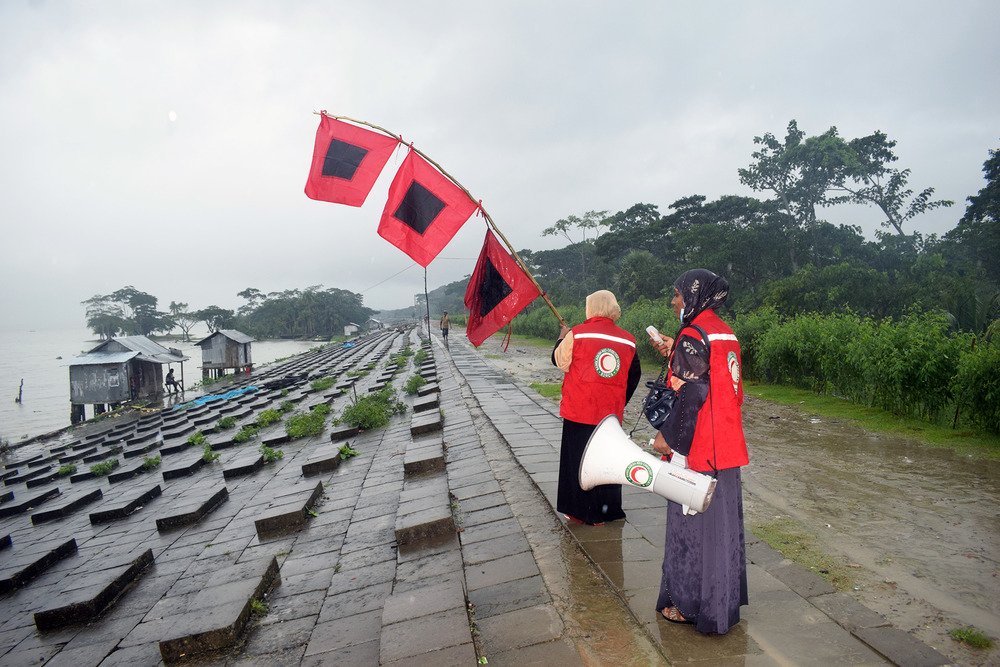
Increasing the number of female volunteers is thought to have helped reduce deaths.
The ratio of cyclone deaths between males and females, for example, decreased from 14:1 in 1970, to 5:1 in 1991. Last year, that ratio was 1:1, according to the Ministry of Disaster Management and Relief.
“Cyclone early warnings usually go to men in the community, because dissemination is often done in public places and women don’t have access to mobile phones at the same level as men do,” according to Dilruba Haider, programme specialist with UN Women.
Volunteers use a set of coloured flags: one flag for precaution, two for danger and three for great danger – as well as megaphones and hand-operated sirens.
Other countries such as Indonesia, Pakistan and the Philippines have similar volunteer programmes, but they tend to be smaller in scale and run by NGOs. Bangladesh is also unusual in that it has a gender-parity policy.
In 2021, the CPP started working on other hazards than cyclones. Now, volunteers are also trained to search urban areas after an earthquake, monitor high tides, or rescue people from drowning.
Multi-purpose shelters
When Bhola struck, in 1970, there were only 44 operational cyclone shelters for a population of roughly 65 million people.
By the time Cyclone Gorky made landfall in 1991, killing about 140,000 people, the number of shelters had increased to 512 – providing protection to roughly 10% of the coastal population.
Now, Bangladesh has more than 14,000 shelters, which allowed around 2.4 million people to be evacuated in 2020 during Cyclone Amphan – the most powerful storm to form on the Bay of Bengal since 1999, according to a report from the International Federation of Red Cross and Red Crescent Societies (IFRC).
“We were warned of Cyclone Amphan by volunteers with flags and megaphones. We also heard alarms from the mosque’s speakers,” said Abdur Rahman Gazi, 48. “My family and I went to the shelter. Despite losing our home, we were able to save our lives.”
Unlike earlier designs, new shelters are used and maintained throughout the year.
Each building can accommodate between 500 and 2,500 people. The new multi-purpose shelters also have wheelchair access, segregated spaces for men and women, and even areas for farm animals.
“One reason people didn’t go to shelter before is that they didn’t want to leave their animals behind,” said Huq, from ICCCAD.
According to a study comparing storm casualties in the region over 25 years, Bangladesh’s shelter programme reduced fatalities by 75% between 1990 and 2015.
Other neighbouring countries have been slower to build shelters.
In 2008, one year after Cyclone Sidr, a similar cyclone called Nargis killed more than 140,000 people in neighbouring Myanmar, partly due to a lack of shelters, according to a 2009 Nature study.
Saving lives, not livelihoods
Bangladesh is expected to face more Category 4 and 5 cyclones in the coming years, according to the latest report from the Intergovernmental Panel on Climate Change (IPCC).
And while the country is managing to reduce deaths, it continues to struggle with internal displacement, economic damage and loss of livelihood. Cyclone Amphan, for example, caused roughly USD 14 billion of damage to the region and destroyed more than 176,000 hectares of agricultural land in Bangladesh, according to a WMO report.
“Tens of thousands of people could not go back home [after Amphan],” Huq told The New Humanitarian. “Their houses were destroyed, their crops were salinated with sea water. Many of them have ended up in the slums of Dhaka.”
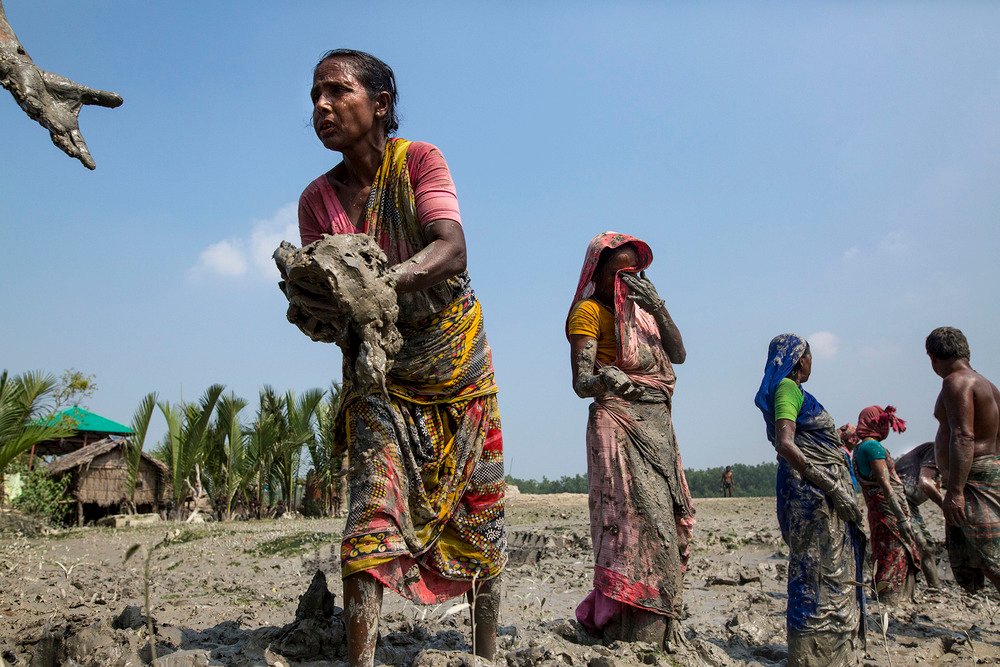
“While we can save their lives, we have not been successful in saving their livelihoods."
Approximately 4.4 million people were displaced in Bangladesh due to disasters in 2020, according to a report from the Internal Displacement Monitoring Centre (IDMC).
Storms, floods and a never-ending circle of destruction and rebuilding efforts are driving people away from coastal villages, while repeated saltwater intrusion is polluting drinking water and undermining agriculture along the coast.
The Environmental Justice Foundation predicts that one in seven Bangladeshis could be displaced by climate change by 2050.
Generational shift
“When I hear the cyclone signal, I know that I have to pack my books and convince my parents to go to the shelter,” Suraiya Akhter, a 15-year-old student from Tobgi Secondary School in Bhola district, told The New Humanitarian.
In Bangladesh, students learn about disaster preparedness early in their curriculum.
“Teachers and students have a big role to play in disaster management,” said Sanaullah Sanu, a teacher in Kamalnagar Upazila, a region along the south coast. “We help with early warnings and preparedness activities, and we are in charge of managing cyclone shelters – often associated with schools in Bangladesh.”
Purnima Sadhu, a 16-year-old student from Tafalbari College in Lakurtala, a village 260 kilometres south of Dhaka, said her generation is acutely aware that cyclones will likely increase due to climate change.
“Our parents did not learn about disasters when they were young, but we do,” said Sadhu, “Climate change will bring bigger disasters in the future, but we know we can prepare for them. We are not afraid.”
Edited by Paisley Dodds; additional reporting from Sabrina Toppa in Pakistan.
This article was originally published by The New Humanitarian, a news agency specialised in reporting humanitarian crises.
About this investigation: Cyclones, floods, droughts. An increasing number of humanitarian crises are being driven by climate change, and it’s often the world’s most vulnerable who are hardest hit. But what if high risk countries were also leading the way by implementing a raft of best practices when it comes to disaster risk reduction? We set out to answer this question in an investigation that spanned six months. One of our findings? Some high-risk countries with struggling economies pack a punch when it comes to lowering disaster-related deaths.
This coverage was supported by a grant from the Solutions Journalism Network.
